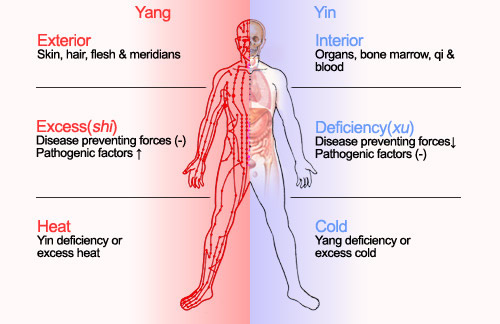Yin Yang Application in TCM Diagnosis
TCM physicians rely on the Four Examination Skills to gather clinical information, while identifying symptoms and signs according to yin and yang is the first priority, which helps physicians reduce the source of disharmony in the body. Generally speaking, yang signs are associated with excitatory, hyperactive, hot, progressing externally, developing upward and improving manifestations. Yin signs, on the other hand, are associated with inhibitory, hidden, passive, cold, progressing internally and developing downward and worsening manifestations.
Below are some yin and yang manifestations that gathered by the Four Examination Skills.
| Yin manifestations | Yang manifestations | |
|---|---|---|
| Inspection | Apathetic, silent, mental fatigue, lusterless and dull complexion, a pale tongue that looks tender and bulky | Agitated, restless, irritability, lustrous and glowing complexion, a red tongue with yellow coating |
| Listening & smelling | A feeble voice, weak and shallow breathing, watery and thin secretions | A loud voice, coarse and fast breathing, thick and sticky secretions |
| Inquiring | Chills, no appetite, prefer hot drinks when thirsty, fatigue, general weakness, loose bowels, plentiful and clear urine, sleepiness, dull pain or soreness, and slow and chronic disease course | Fever, prefer cold drinks when thirsty, mouth dryness, dry and hard stools, scanty and yellowish urine, burning or stabbing pain or colic, acute disease, and rapid onset |
| Palpation and pulse | Pulse is deep, fine, hesitant or slow |
Pulse is floating, surging, rolling or rapid |
Syndrome differentiation (identifying disharmony pattern) is the method of recognizing and diagnosing diseases or body imbalances in TCM. For preliminarily evaluation, the collected symptoms and signs are categorized according to a system known as the "eight principles", which contain four pattern pairs: interior and exterior, cold and heat, deficiency and excess, and yin and yang. Among the eight patterns, yin and yang patterns are the most fundamental and essential. Physicians will first identify whether the disharmony pattern is ascribed to yin or ascribed to yang, because although the pattern may be complex with many changes, it still does not depart from the two major categories.
Below are the four disharmony pairs and their clinical significances:
- Yin / Yang: To determine the relationship between pathogens and healthy energy within the body;
- Interior / Exterior: To determine the diseased region;
- Deficiency / Excess: To determine the strength or weakness of the body;
- Cold / Heat: To determine the nature of the disease.
 The eight principles of TCM
The eight principles of TCM 

